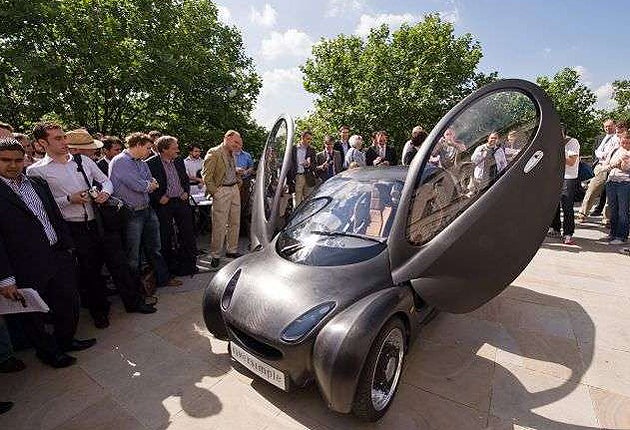The ultimate green car – but where do you fill it up?
The hydrogen-run vehicle unveiled yesterday promises a pollution-free future. But there is a bumpy road ahead

It's silent, it's pollution free, it's nippy, and it'll get you round town for £2,500 a year, fuel and maintenance included. So, is it the car of the future? Maybe.
The developers of the hydrogen-powered Riversimple Urban Car certainly think it is, and when this new British contribution to green motoring was unveiled in London yesterday they did not spare the superlatives. The lightweight two-seater, which has a hydrogen fuel cell powering four electric motors, will cut travelling costs and do more to save the planet, they said, than any other car on the road.
That's if it gets there. What was unveiled yesterday on the terrace of Somerset House overlooking the Thames was a demonstration model and before the Riversimple can come off the production line and take its place in the traffic, many obstacles have to be crossed.
The biggest one is the hydrogen, which goes into the fuel cell in liquid form, at a very low temperature. There is no hydrogen refuelling infrastructure in Britain, or anywhere else for that matter, and at present no-one is proposing to build one, especially seeing the billions of pounds it would cost.
The answer to this from the engineer behind the Riversimple, Hugo Spowers, is to keep it local. Mr Spowers wants to go into partnership with a British city – he has Oxford in mind, among others – in which 50 vehicles would be based and leased to customers. As the car is intended to be a city runabout, rather than for long journeys, there would only need to be a single refuelling point in each urban centre, he says. If more cities took up the idea, Mr Spowers predicts a national hydrogen refuelling network could come into existence of its own accord.
But before he can get to that stage he has to raise another £20m of investment, of which "a proportion", he said yesterday, had been secured. The Riversimple publicity made much of the backing of Sebastian Piech, a member of the Piech motoring dynasty involved in running Porsche and Volkswagen, but Mr Spowers made it clear that Mr Piech was investing privately and not on behalf of any major German car company.
The advantages of the Riversimple, assuming it lives up to everything claimed by the makers, are considerable. It can reach a top speed of 50mph, which is comparable to that of the electric G-Wiz, but with a carbon fibre body and a much lighter fuel cell than in other hydrogen vehicles it is claimed to have a range on one fuel charge of 240 miles – five times the distance the G-Wiz can travel before recharging.
Above all, with a hydrogen fuel cell no carbon dioxide is emitted from the exhaust to add to the greenhouse gases causing global warming, which would be a principal reason for many people to buy the car. But Mr Spowers did admit that the emissions were in fact 30grams of CO2 per kilometre travelled, reflecting the amount of CO2 released in the industrial process needed to make the hydrogen. But even this, he said, was "a quarter of the lowest emissions of any car in the market today", and there was a prospect of "green" hydrogen in the future, made with renewable energy, when the CO2 would shrink even lower.
Join our commenting forum
Join thought-provoking conversations, follow other Independent readers and see their replies
Comments
Bookmark popover
Removed from bookmarks